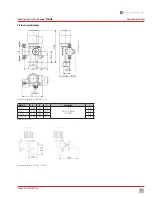
7. Installation
7.1 General information
Local rules and regulations must be taken into account when selecting a dosing pump for designing a system, and for installation and operation. This applies to
the selection of the appropriate materials for the dosing pump, the handling of chemicals, and electrical installation.
Before installing the pump in areas with a potentially explosive atmosphere, the dosing pump must be checked to ensure that it meets the minimum requirements
set by the applicable explosion protection regulations. For this purpose, the data on the dosing pump rating plate must be compared with the local requirements.
The technical specifications of the dosing pump (section 5, page 13) must also be taken into consideration, and the system designed accordingly (e.g. pressure
loss for pipe dimensions i.e. nominal diameter and length).
ATTENTION!
For the Encore
®
MB/ME 75 and 76, pipe dimension must be at least DN 10. The DN 6 pipe dimension is permissible only for short lines (up to 6.6 feet (2 m)) and
low-viscosity media (<50 mPa s) .
The designer and operating company are responsible for ensuring that the whole system, including the dosing pump, is constructed so that neither system
parts nor buildings are damaged in the case of chemical leakage due to the failure of wear parts (e.g. diaphragm rupture) or burst hoses. If the chemical system
represents a potential source of danger, the installation must be designed so that no unreasonable consequential damage occurs, even if the dosing pump fails.
We therefore recommend installing leakage monitors and collecting pans.
The drain pipe of the dosing head must be visible so that a diaphragm rupture can be detected. Drainage should be able to flow freely downward through the
drain pipe.
To increase dosing accuracy and ensure functional reliability, we recommend installing additional valves and accessories. These include back-pressure valves,
pressure-relief valves, leakage monitors and low level indicators, as shown in the installation examples.
Always use appropriate tools when installing plastic connecting parts. To avoid damage, never apply excessive force.
IMPORTANT!
Plastic parts (especially PVC parts) can be tightened and loosened more easily by applying lubricant to the thread beforehand (e.g. silicone grease).
Threaded stainless steel parts (e.g. dosing head and valves) must be lubricated before being assembled (e.g. with PTFE spray), in order to prevent seizing.
ATTENTION!
Check the lubricant for compatibility with the chemical.
7.1.1 Installation of Encore
®
ME with ATE servomotor
When delivered, the ATE servomotor is already connected to the dosing pump and adjusted. When installing, sufficient installation space of at least 5.9 in. must be
provided in order to allow later maintenance.
The electrical connection of the ATE servomotor must be made according to local regulations and may only be carried out by qualified technical personnel. The
wiring diagrams (section 7.5) show the two basic connection variants.
Cable type and cross-section must be chosen according to the motor data.
The cable passage through the housing must be made professionally. We recommend using gland connections with strain-relief clamp. The required protection
class must be ensured by professional-standard installation of the electrical connections.
19
Diaphragm Dosing Pump
Encore
®
MB/ME
Operating Instructions
CF.450.410.001.IM.1114
Summary of Contents for Encore MB
Page 3: ...3 Diaphragm Dosing Pump Encore MB ME Operating Instructions CF 450 410 001 IM 1114 ...
Page 48: ...48 Diaphragm Dosing Pump Encore MB ME Operating Instructions CF 450 410 001 IM 1114 ...
Page 50: ...19 Notes 50 Diaphragm Dosing Pump Encore MB ME Operating Instructions CF 450 410 001 IM 1114 ...
Page 51: ...51 Diaphragm Dosing Pump Encore MB ME Operating Instructions CF 450 410 001 IM 1114 ...
Page 52: ...Encore MB ME Diaphragm Dosing Pump MANUAL NO CF 450 410 001 IM 1114 CF 450 420 001 IM 1114 ...
















































